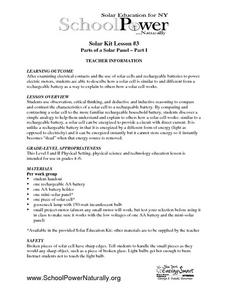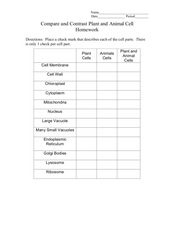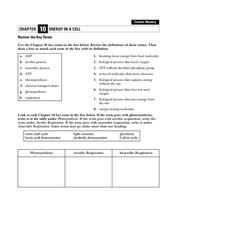Curated OER
Cancer Causes
Students explore why people get cancer. They explore human cells by taking a close examine their own. take a small sample of the epithelial cells that line the inside of their mouth. They glimpse how scientists investigate inside cells.
Curated OER
Parts of a Solar Panel-Part I
Young scholars examine electrical contacts, solar cells, and rechargeable batteries and compare and contrast the characteristics of a solar cell to a rechargeable battery in a hands-on activity. Students complete a worksheet as they...
Curated OER
The Nash Case -- Identifying, Choosing and Using Genes
Students complete a variety of exercises as they examine the case of the Nash family who conceived one child in order to provide cells that may be used in a cell transplant for a dying sibling.
Curated OER
Sets of Chromosomes
For this chromosome worksheet, students answer eighteen questions about chromatids, chromosomes, types of reproduction, haploid and diploid cells and zygotes.
Curated OER
Science Lessons
Tenth graders research about the different cell organelles. In this series of biology lessons, 10th graders compare two allotropes of carbon. They investigate how the rate of reaction is affected by concentration.
Curated OER
Solar Car Series: During what part of the day can t most Sun power be collected?
Students participate in an outdoor activity in which they make direct but safe observations of the Sun. Students use a solar cell and voltmeter apparatus to collect data on the amount of DC voltage produced by the solar cell during a...
Curated OER
Solar Energy Connection
Students conduct solar experiments. They calculate the solar gain and operate a solar cell devise used to generate electricity. Students compare and contrast solar energy gain with students in India. They analyze the difference...
Curated OER
Chemistry Quiz 4-Redox Reactions
In this oxidation/ reduction worksheet, students solve eight multiple choice problems related to redox reactions. They determine half reactions, they calculate standard cell potentials, they identifying oxidizing and reducing agents and...
Curated OER
No Escape
Via four student handouts, marine biology learners examine the topography and circulation cell of the Fieberilng guyot. Then they examine the number of individual hydroids counted at each depth. Pupils use the information to relate water...
Curated OER
Compare and Contrast Plant and Animal Cell
In this plant and animal cells worksheet, students complete a chart, checking features that describe cell parts. Features will describe either plant, animal, or both types of cells.
Curated OER
Extract Your Own DNA from Cheek Cells
Students observe their own DNA. In this DNA lesson, students learn the simple method of DNA extraction and explain why DNA extraction is important to scientists.
Curated OER
Energy in a Cell
In this cell energy learning exercise, students will use an energy map to investigate how cells create ATP to store energy and how ATP loses a phosphate to release the energy to the cell. Students will then complete 4 short answer...
Curated OER
Creating a Plant Cell Journal
Learners discover the anatomy of a plant by illustrating plant cells. In this botany lesson, students research information about plant cells and draw pictures of cells in a plant journal. Learners organize their notes into an...
Curated OER
Energy in a Cell
In this cell energy worksheet, students will match 8 terms with their definitions relating to the biological processes that create energy in a cell. Then students will match 6 terms as being a part of photosynthesis, aerobic respiration,...
Curated OER
Number of Cell phones in Use Per Household
In this cell phones activity, students study a bar graph of the number of cell phones usage in households. Students answer 5 questions about the graph.
Curated OER
Energy in a Cell
In this cell energy worksheet, learners will describe the steps of photosynthesis. Then students will use a photosynthesis energy map and an aerobic respiration energy map to complete 2 short answer questions.
Curated OER
TV on Cell phones? Funny but Profitable
Students explore the concept of technology. In this technology instructional activity, students read an article about television on a cell phone. Students discuss why MobiTV was successful. Students discuss a technology and possible...
Curated OER
The Case of Regulation in Cells
After your biologists have learned about transcription, translation, and gene regulation, they work in a small group to create a poster of a system that serves as an analogy of the gene regulation process. They share their creations with...
Curated OER
How Substances Get in and out of Cells
Although it contains some formatting issues, the Word document here contains good questions about osmosis and diffusion, and is easy to edit as needed. Designed as a study guide, you could use the information here for warmups, ideas for...
Curated OER
The Nervous System: Basic Organization and Function
A vintage learning exercise on the basic structure and function of the nervous system awaits your beginning biologists. Although it pertains to a textbook chapter reading, the content is relevant to any introductory unit on the nervous...
Biology Junction
Introduction to Biology Crossword
In this introduction to biology, students complete a crossword puzzle with 22 questions. They identify common terminologies used in the study of biology.
Curated OER
Human Excretion: Living Environment
A solid review of the excretion system that presents diagrams and asks learners to name the labelled parts or to identify which parts perform the particular jobs stated.
Curated OER
The Great Animal Systems Challenge!
Advanced placement biology aces list systems that have evolved over time, adaptations, and structure-function relationships. The resource requires plenty of writing to answer these questions, so allow a few days for them to complete the...
Curated OER
Describing Animals
While a short review of animals and their classifications, this could be useful when discussing this topic in the classroom. There is a list of questions at the end to help review the main ideas. Reptiles, amphibians, and mammals are...
Other popular searches
- Animal Cells
- Plant and Animal Cells
- Plant Cells
- Stem Cells
- Eukaryotic Cells
- Blood Cells
- Cells Crossword
- Cells and Organelles
- Cheek Cells
- Life Science on Cells
- Microscope Cheek Cells
- 3d Animal Cell

























